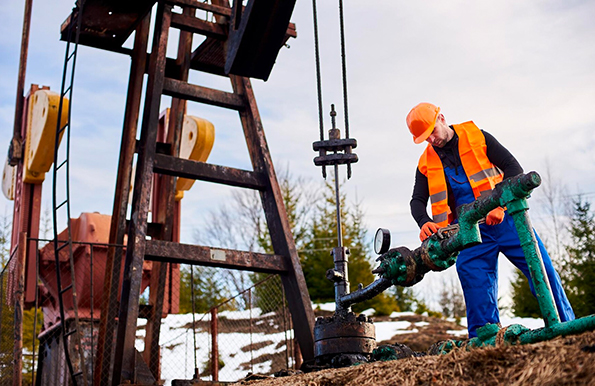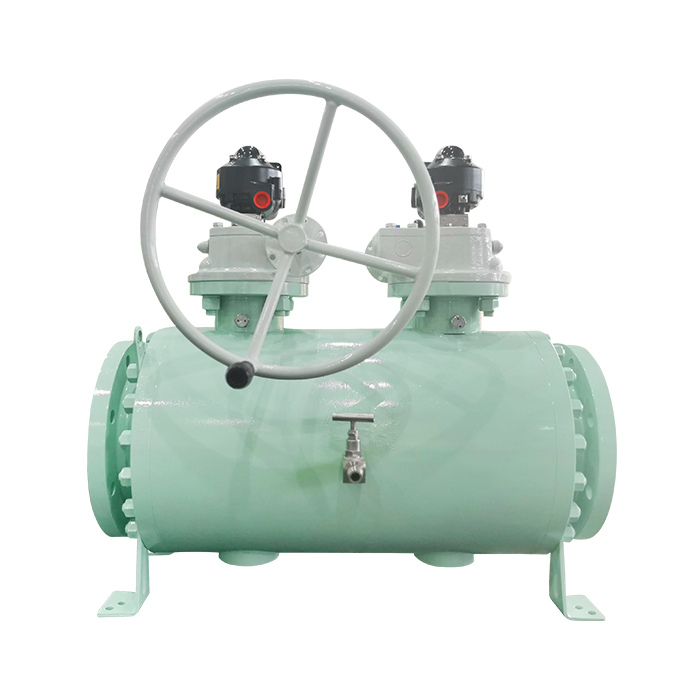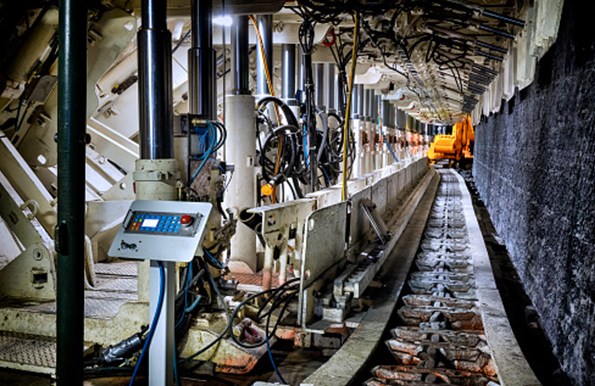The process of excavating underground to obtain minerals, oil, and gas is known as underground drilling. It is a complex and challenging operation requiring specific equipment and techniques to be completed safely and quickly.
Underground drilling equipment delving through hard rock and soil layers is critical to this procedure. The valve is a crucial component of underground drilling machines.
Valves control the flow of fluids through the drill string and borehole, such as drilling mud and air. They are critical for maintaining proper pressure and flow during drilling and minimizing harmful gas buildup.
In underground drilling, many industrial valves are utilized, each designed for a specific function. A mud gate valve, for example, controls the flow of drilling mud through the drill string, whereas a blowout preventer valve prevents the uncontrolled escape of gas or oil.
Industrial valve operation is critical for subsurface drilling equipment’s safe and effective procedure. A valve failing to function correctly can cause several issues, including drilling delays, equipment damage, and even safety hazards.
As a result, regular maintenance and examination of industrial valves are required to guarantee that they are in good operating order. Underground machinery drilling is a difficult procedure requiring specialized equipment and techniques to be completed safely and quickly.
Industrial valves are essential to this equipment because they control fluid flow and help maintain proper pressure and flow during the drilling operation. Valve maintenance and inspection are required regularly to ensure that they are in good operating order and to minimize drilling delays, equipment damage, and safety issues.
By choosing a reputable butterfly valve manufacturer, one can be confident that the valves used in the underground drilling operation will meet the necessary requirements for safe and efficient operation.
Methods of Drilling
There are various drilling technologies used in underground mining and exploration. The intricacy of these procedures and the type of equipment required varies. They are chosen based on the specific characteristics of the location and the resources being harvested.
Drilling with a Rotary Bit
Rotary drilling is the most prevalent form of underground mining drilling. To cut through the rock or dirt, a rotary drill bit that is revolved at high speeds is used. The drill string, which is made up of a network of pipes, is used to deliver rotational force and drilling fluid to the drill bit, such as an underground water drilling machine or drilling mud.
Drilling Using Percussion
Percussion drilling breaks up the rock or soil by hitting it. The drill bit is attached to a piston, which impacts the drill bit repeatedly to make a hole. This technique is frequently employed for drilling shallow holes or in soft rock formations.
Drilling with Diamonds
Diamond core drilling is a drilling technique that involves using a diamond-tipped drill bit to carve a cylindrical core of rock. The hole’s core is then extracted and tested to identify the mineral content of the rock. This technique is widely utilized in mineral exploration and mining.
Drilling using Reverse Circulation
Reverse circulation drilling creates a circulating flow of drilling fluid by using a dual-wall drill pipe and a high-pressure pump. This method is often utilized in mineral exploration and mining because it provides for a more efficient and faster drilling operation.
Drilling using a Cable Tool
Chain tool drilling is an older technology that employs a hefty weight on a cable to repeatedly drop a drilling bit into the hole. This technique is most commonly employed for shallow drilling and water well drilling.
Each of these processes has distinct advantages and disadvantages. The method used is determined by the specific characteristics of the location and the resources being taken. Rotary drilling, for example, is ideal for drilling deep holes in complex rock formations, whereas diamond core drilling is ideal for recovering a continuous core of rock for study.
Underground Drilling Equipment

Underground drilling equipment refers to the specialized machinery used to excavate underground mines and oil and gas wells. Drilling equipment is a vital component of the mining and oil and gas extraction industries, enabling the extraction of valuable resources from beneath the earth’s surface.
The following is a list of common underground drilling equipment:
Industrial Valves

Industrial valves play a crucial role in controlling the flow and pressure of liquids, gases, and other substances in various industrial applications. They are mechanical devices that are used to ensure the proper functioning of systems that require precise control.
In drilling systems, valves are utilized to control the flow and pressure of drilling fluids, gases, and other substances. Some examples of industrial valves are gate valves, check valves, ball valves, and pressure relief valves.
Pipeline valves serve multiple functions, including shutting off fluid flow, regulating flow rate, preventing backflow, and releasing pressure to ensure safety. In addition, they also maintain system pressure. To choose the right pipeline valve, it is essential to have a comprehensive understanding of the working environment and the specific function the valve will serve.
Drilling Rig
A large machine is used to drill holes into the earth’s surface for the purpose of extracting minerals, natural gas, or other subsurface resources. Drilling rigs vary significantly in size and complexity depending on their purpose but typically consist of some combination of a drill string, hoisting mechanisms, and other drilling equipment.
Drill Bit
A drill bit is a cutting tool attached to the end of a drill string that is used to cut into rock or soil to create a borehole for drilling purposes. Drill bits come in a variety of shapes and sizes, and are made from hard materials such as tungsten carbide, steel, or diamond.
Drill String
A column of interlocking sections of drill pipe used in drilling operations to transmit drilling fluid, torque, and other forces from the surface to the drill bit at the bottom of the borehole. The length of the drill string can vary depending on the depth of the hole being drilled, and the weight of the drill string helps to maintain pressure and stability in the borehole.
Mud Pump
It is a machine used in drilling operations to circulate drilling fluid (also known as “mud”) through the drill string and borehole. The mud pump is a crucial component in drilling operations, as it helps to lubricate the drill bit, remove cuttings from the bottom of the hole, maintain pressure in the borehole, and cool and protect the drill bit and other equipment.
Derrick
Used in drilling operations to support the drill rig and hoist and lower equipment. The derrick is used to raise and lower the drill string, to support the drill bit and other equipment, and to control the direction of the drill hole. The height of the derrick depends on the depth of the hole being drilled, and the design of the derrick can vary depending on the type of drilling and the specific drilling conditions.
Rotary Table
A rotary table is a component of a drilling rig used to rotate the drill string and drill bit. It is positioned above the drill floor and is powered by an electric or hydraulic motor. It is used to turn the drill string, which allows the drill bit to cut into the rock or soil and create the borehole.
Kelly
A kelly is a square or hexagonal bar used in drilling operations to transfer rotational force and torque from the rotary table to the drill string. It is used to control the direction and speed of drilling and is an essential component of the drilling rig.
Swivel
A swivel is a mechanical device used in drilling operations to transfer rotational force and torque from the rotary table to the drill string. The swivel is an important component of the drilling rig, as it helps to ensure smooth and efficient operation of the drilling process
Drill Collars
Drill collars are heavy, cylindrical pieces of steel used in drilling operations to add weight to the drill string and provide stability to the borehole. Drill collars are positioned near the bottom of the drill string, above the drill bit, and are used to counteract the tendency of the drill string to bend and buckle as the drill bit cuts into the rock or soil.
Casing
A casing is a large diameter pipe that is used to line the borehole in a well. The primary purpose of casing is to provide structural support to the wellbore, prevent the collapse of the borehole, and isolate various subsurface formations.
How to Choose the Right Drilling Equipment to Ensure Safety

The proper drilling equipment is essential for guaranteeing safety in underground machine mining and exploration operations. The depth and direction of the boreholes are essential factors to consider while purchasing drilling equipment.
Borehole Depths
The depth of the boreholes will determine the sort of drilling equipment that is most appropriate. Rotary drilling, for example, is best suited for drilling deep holes, whereas percussion drilling is better suited for shallower holes. It is critical to select a drill rig that is powerful enough to drill to the appropriate depth while causing no damage or downtime.
Borehole Orientation
The direction of the boreholes will also determine the sort of drilling equipment that is most appropriate. Some drill rigs, for example, are built to drill vertical holes, while others are geared to drill horizontal or inclined holes. Selecting a drill rig that can drill in the desired direction is critical.
Drill Rigs With Lower Horsepower
Lower-powered drill rigs may be more appropriate for the site conditions and the resources being extracted in some circumstances. These drill rigs are usually smaller and less powerful than other drilling equipment, but they are also easier to maneuver and require less maintenance.
They are convenient for drilling in confined spaces or areas with restricted access. The safety features of the drilling equipment, including the industrial ball valve, the ease of maintenance and repair, and the qualifications and training of the operators are all significant factors in the selection process. Mining and exploration operators can select drilling equipment that is safe, efficient, and well-suited to the specific requirements of the site by taking into account all of these criteria. This will help to reduce downtime, ensure the safety of the personnel, and maximize the operation’s productivity.
Conclusion
Underground drilling machines are an essential component of the mining industry, and selecting them requires careful consideration of various factors, including cost, productivity, and security concerns. Dombor specializes in the development of industrial valves, and offers an essential solution that can be used for machines that are used for drilling underground.
Valve supplier Dombor can provide technical help and solutions at a single point of contact for the global market thanks to its experienced staff. As an industrial valve company, Dombor offers a diverse range of valves, both standard and custom, all designed to fulfill specific industrial requirements. It makes the company an outstanding option for any market.









